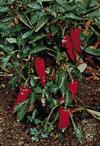- pepper
-
—pepperer, n. —pepperish, adj. —pepperishly, adv./pep"euhr/, n.1. a pungent condiment obtained from various plants of the genus Piper, esp. from the dried berries, used whole or ground, of the tropical climbing shrub P. nigrum.3. any of several plants of the genus Capsicum, esp. C. annuum, cultivated in many varieties, or C. frutescens.4. the usually green or red fruit of any of these plants, ranging from mild to very pungent in flavor.5. the pungent seeds of several varieties of C. annuum or C. frutescens, used ground or whole as a condiment.v.t.7. to season with or as if with pepper.8. to sprinkle or cover, as if with pepper; dot.9. to sprinkle like pepper.10. to hit with rapidly repeated short jabs.11. to pelt with or as if with shot or missiles: They peppered the speaker with hard questions.12. to discharge (shot or missiles) at something.[bef. 1000; ME peper, piper, OE pipor ( > ON pipari, piparr) < L piper < Gk péperi; cf. OFris piper, D peper, OHG pfeffar (G Pfeffer); these and OE pipor perh. < a common WGmc borrowing < L]
* * *
Ior garden pepperAny of many plants in the genus Capsicum of the nightshade family, notably C. annuum, C. frutescens, and C. boccatum, native to Central and South America and cultivated extensively throughout tropical Asia and the equatorial New World for their edible, pungent fruits.Red, green, and yellow mild bell or sweet peppers, rich in vitamins A and C, are used in seasoning and as a vegetable food. The pungency of hot peppers, including tabasco, chili, and cayenne peppers, comes from the compound capsaicin in the internal partitions of the fruit. The spice black pepper comes from an unrelated plant. Red peppers (Capsicum annuum) from which paprika is madeG.R. RobertsII(as used in expressions)garden pepperPepper Claude Denson
Red peppers (Capsicum annuum) from which paprika is madeG.R. RobertsII(as used in expressions)garden pepperPepper Claude Denson* * *
▪ Capsicumalso called Garden Pepper(Capsicum), any of a great number of plants of the nightshade family, Solanaceae, notably Capsicum annuum, C. frutescens, and C. boccatum, extensively cultivated throughout tropical Asia and equatorial America for their edible, pungent fruits. Peppers, which have been found in prehistoric remains in Peru, were widely grown in Central and South America in pre-Columbian times. Pepper seeds were carried to Spain in 1493 and from there spread rapidly throughout Europe.The genus Capsicum comprises all the varied forms of fleshy-fruited peppers grown as herbaceous annuals—the red, green, and yellow peppers rich in vitamins A and C that are used in seasoning and as a vegetable food. Hot peppers, used as relishes, pickled, or ground into a fine powder for use as spices (spice and herb), derive their pungency from the compound capsaicin, a substance characterized by acrid vapours and burning taste, that is located in the internal partitions of the fruit. First isolated in 1876, capsaicin stimulates gastric secretions and, if used in excess, causes inflammation.In addition to the cherry (Cerasiforme group) and red cluster (Fasciculatum), these hot varieties, which are red when mature, include the tabasco (Conoides), which is commonly ground and mixed with vinegar to produce a hot sauce, and the long “hot” chili and cayenne (Longum), often called capsicums. Cayenne pepper, said to have originated in Cayenne in French Guiana, is one of the spices derived from these peppers and is produced in many parts of the world.The mild bell or sweet peppers (bell pepper) (Grossum) have larger, variously coloured but generally bell-shaped, furrowed, puffy fruits that are used in salads and in cooked dishes. These varieties are harvested when bright green in colour—before the appearance of red or yellow pigment—about 60–80 days after transplanting.The term “pimiento,” from the Spanish for “pepper,” is applied to certain mild pepper varieties possessing distinctive flavour but lacking in pungency; these include the European paprikas (paprika), which include the paprika (q.v.) of commerce, a powdered red condiment that was known in Hungary by the late 16th century. “Pimiento,” often pronounced the same as “pimento,” should not be confused with the latter, which is allspice.Pepper plants are treated as tender summer annuals outside their native habitat. They are propagated by planting seed directly in the field or by transplanting seedlings started in greenhouses or hotbeds after six to ten weeks.* * *
Universalium. 2010.
